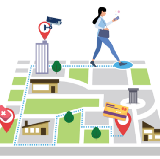How Korea Is Reopening
The official guide to routine distancing

These are the official reopening guidelines from South Korea, translated by the COVID Translate Project. But actually, it’s not a reopening guide at all.
They call it the Detailed Guidelines for Routine Distancing in Daily Life.
There’s no reopening because Korea never closed. Everybody else, however, did, so I’ll just call it reopening. As we stumble into a new, distant world, this is how one non-basket-case country is doing it. There’s a lot we can learn.
Before we get into it, I must note that reopening is hard.
Just a few days in, Korea had another outbreak. One person went clubbing in Itaewon and now they have nearly a hundred new cases, many of them asymptomatic. And because it was in a gay district, it’s exposing dangerous fissures in society.
No plan survives first contact with the enemy, but let’s see what we can learn from Korea.
Prerequisites
Because relapses are almost guaranteed, you must have a strong test/trace/isolate regime in place. If you don’t have strong public health tools, you’ll have to lockdown until you do. You can only safely reopen when your caseload is near zero, and when your public health game is tight.
That’s a prerequisite.

So you’re at zeroish cases and you have a shelf full of tests and PPE (I mean, lol, but OK). How does your country get back to work?
Here’s the guide.
It’s a bit long so I’ve made pictures.
1. The Common Guidelines

These guidelines are for everybody and every situation. If you scroll no further, understand this.
Distance.
The strongest defense we have is simply increasing the distance between human beings. We cannot control the biology of COVID-19 but we can beat it with physics. If we move two meters or two weeks across the curvature of space, we can escape the virus. For example:
- If you’re not feeling well or just got off a flight, stay home for 14 days
- If you can do it online, do that
- If you must go out, stay 2m away
Spacetime is a blunt instrument, but it works.
Beyond that, our main weapons are masks (required indoors), basic hygiene, disinfection, and ventilation. Wash your hands like Lady Macbeth, cough into your elbow, use bleach (not on your lungs), mask up, and clear the air. But above all, just keep your distance.
For Managers
Personal distancing on its own, however, isn’t enough. We don’t personally control our workplaces or spaces in general. Therefore, these guidelines are at least half directed towards managers. Leaders of every organization must:
- Designate Epidemic Control Officers
- Send cases of more than 2–3 people for testing
- Report clusters to public health
- Ensure that people can keep a 2m distance
- Provide hand sanitizer, masks, and regular disinfection
- Provide natural ventilation, if possible
This may seem like a long, boring list, so I’ve tried to illustrate it below.
This is how the guidelines would work in a typical office.
2. Offices
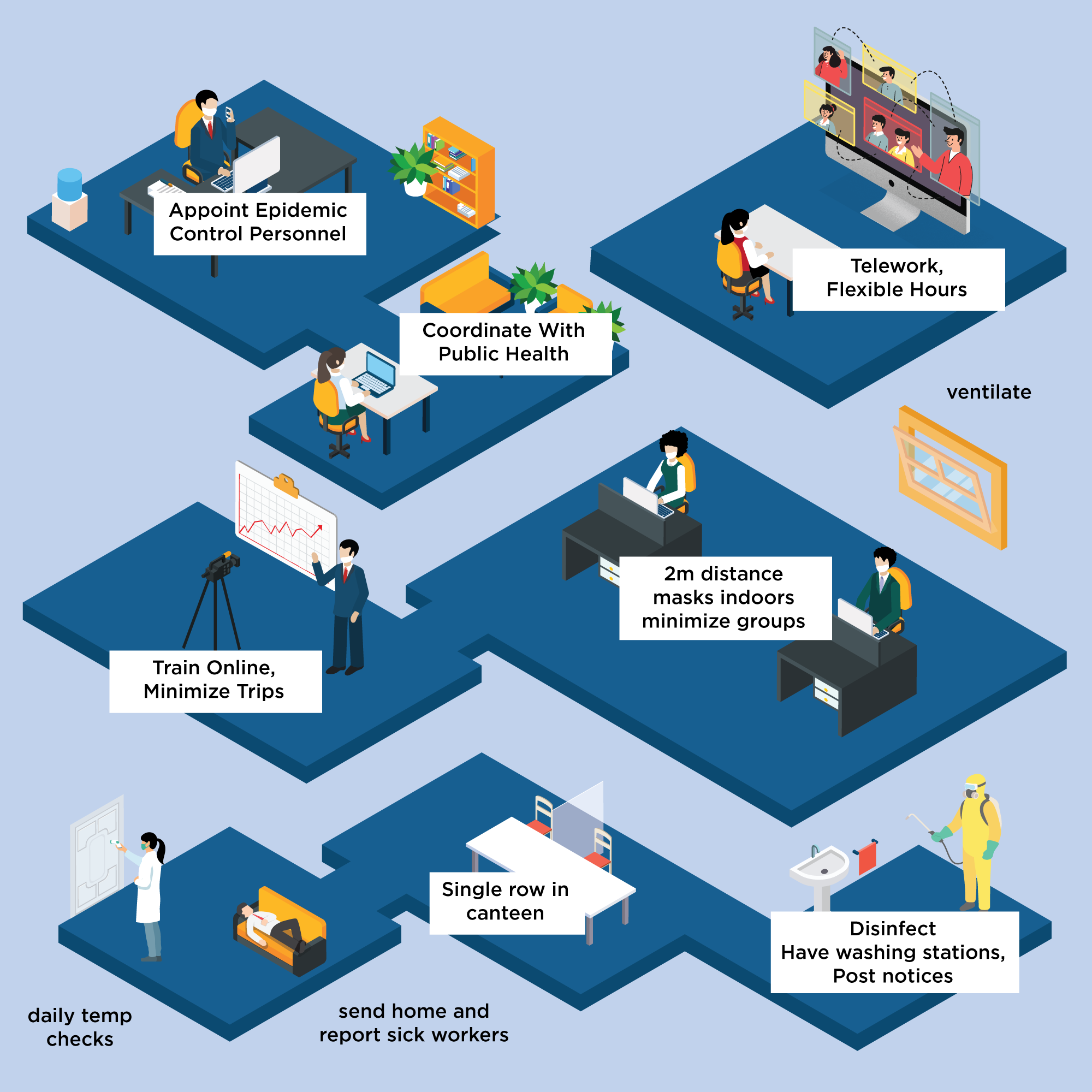
An open-plan office is, to a virus, a buffet. Everyone close together, breathing the same recirculated air, sitting face to face. We can’t do it anymore. This has to change, and that change has to come from the top. Your boss needs to care, and they need to appoint Epidemic Control Officers to get it done. Each office needs to be treated as its own city, with its own disease control.
The goal here, again, is distance. Spreading your office out across spacetime.
You can spread out physically by sitting 2m apart, or better, by working remotely from 20km away. You can also spread out in time by having staggered office hours, and everyone going home early without socializing.
Honestly, this may be a good thing.
People can go home on time, and not just be there to show your infectious face. All of the soul-deadening group rituals can go as well. Long meetings, big workshops, business trips, team-building exercises. It either goes digital or just disappears.
Maybe offices could even start providing offices again. I’ve never had a door before. I wonder what that’s like.
Only then do the guidelines get to the COVID specific stuff.
On that front, offices must make masks and hand-sanitizer available. They must check temperatures daily and have clear protocols if people fall sick. Surfaces need to be regularly disinfected. Physical layouts have to change. Windows need to be opened. This is all important, but honestly secondary to the big cultural changes required.
For example, take meetings. Please.
Meetings
People have been asking ‘could this be an email?’ for years. Now the government is telling you.
The safest meeting is one you don’t have, or one you have digitally. If you must have a meeting, it should be in a big space and not run for more than an hour. This is all common sense, and apparently good for public health.
Here’s what routine distancing recommends:
- Don’t have in-person meetings unless you have to. Here’s a flowchart to decide.
- If you must, have a video or audio call. Improve facilities so this doesn’t suck.
- If you really must, then call a physical meeting. Choose a large, well-ventilated room, seat everyone 2m apart, and ensure masks and hand san.
- Is the meeting going longer than an hour? A) WTF and B) take a break to ventilate the room.
Honestly, I think this new culture is an improvement. Meetings can be very important, but they are also overused. If we think of them as potentially lethal options we’ll use them better, or just turn them into emails.
3. Government Offices
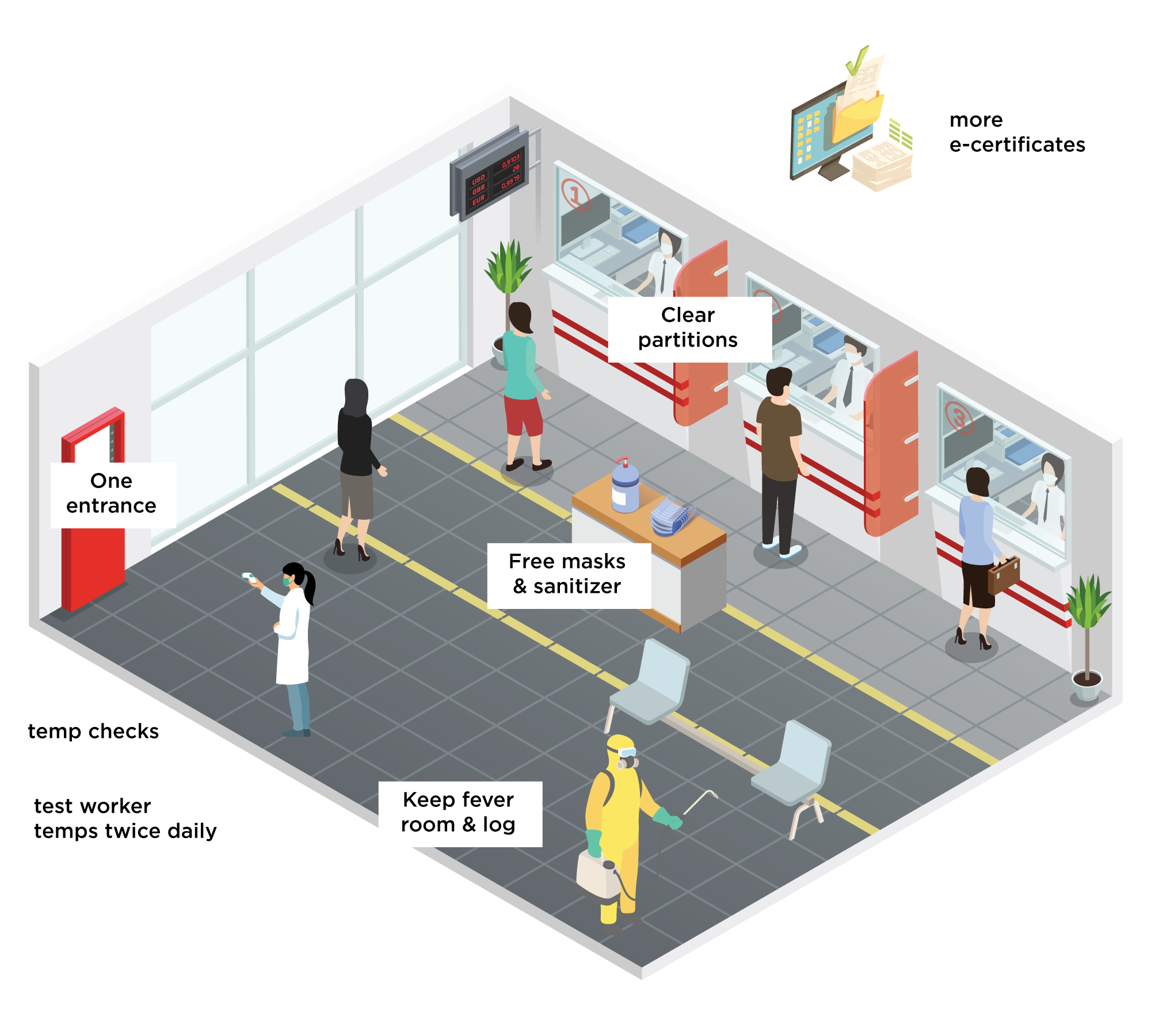
Government offices have the same rules, but they can’t avoid citizens as much as back offices. They can try e-certificates, but until the Korean New Deal kicks-off, people will still physically go.
The civil service, therefore, need generous leave, flexible hours, and expanded rosters (ie, more people). They also need to be protected, ideally behind glass, and then masks.
Citizens should only enter through one door, be temperature scanned, and then sent to a dedicated, logged fever room if there’s an issue. Before they reach the counter, they should be offered free sanitizer or masks, if needed.
In this way, you can protect government workers and the people who come in contact with them.
Something going wrong here is a bit intense. If anyone is reported you need to shut the whole place down, disinfect, and report it to the public health officials. So good record-keeping of who comes and goes is important as well.
4. Public Transit

The advice for public transit is mostly common sense. Who doesn’t want distance on the train?
Don’t talk, leave empty seats, and wait for the next ride if it’s crowded. A sad day for perverts, but most of us are trying to avoid people on a good day. It’s just rush hour and we don’t have a choice.
Distancing on public transit is really an output of the workplace changes above. If offices allow teleworking, staggered hours, and reduce unnecessary travel then you’ll get fewer people on public transit.
There’s some stuff public transit can do — regular ventilation, mask-wearing, and posting notices — but not much.
Employees can’t move rush hour. Managers and business owners need to be aware, and they need to change office culture from the top. The public transit will get less crowded. We have to change the idea that every worker must be in the same place at the same time.
What we call rush hour is, to a virus, just lunch.
A note on risk
It’s important to remember that public transit is relatively safe. In Korea, sitting next to an infected person is not deemed a close contact if you’re wearing a mask. The greatest risk still comes from the people close to you, not strangers.
5. Restaurants
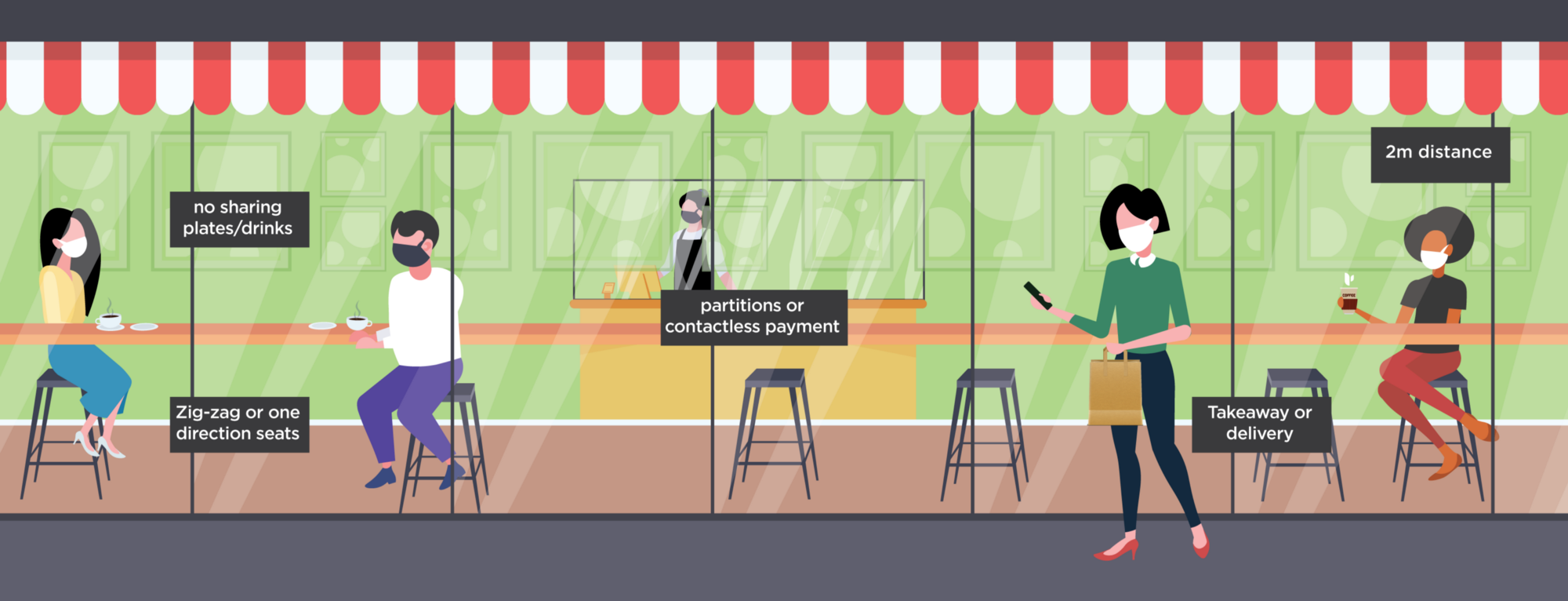
For restaurants, the 2m rule is hard, because that’s not how humans eat. In Asian cultures, for example, we don’t just sit together, we often share the same plate. Hot pot is literally dipping into the same soup. That’s got to go.
Instead, restaurants need to seat everyone facing the same direction, or in a zig-zag pattern, all 2m apart. Like you’re being stood up, like you’re waiting for a date that never comes.
Restaurants need to remove chairs, or installing partitions. This, of course, reduces capacity (and revenue). Some European cities are removing cars and just giving restaurants the whole street. This is great, because ventilation is your friend.
As people eat, they cannot share plates or drinks. Just serve your food, eat facing no one, pay through plexiglass, and go.
Restaurants also have to encourage delivery and takeaway. This isn’t in the guidelines, but I’ve worked in the delivery business, and that partner is easily taking 30%. Whenever possible, order direct, it helps the restaurant out.
Needless to say, this new restaurant routine kinda sucks, but it is much better than nothing and infinitely better than death. But gosh, it won’t be the same. I still remember going to a restaurant in Seoul where the hot plate was surrounded by bubbling cheese. We all dipped in. This seems criminal now.
6. Schools
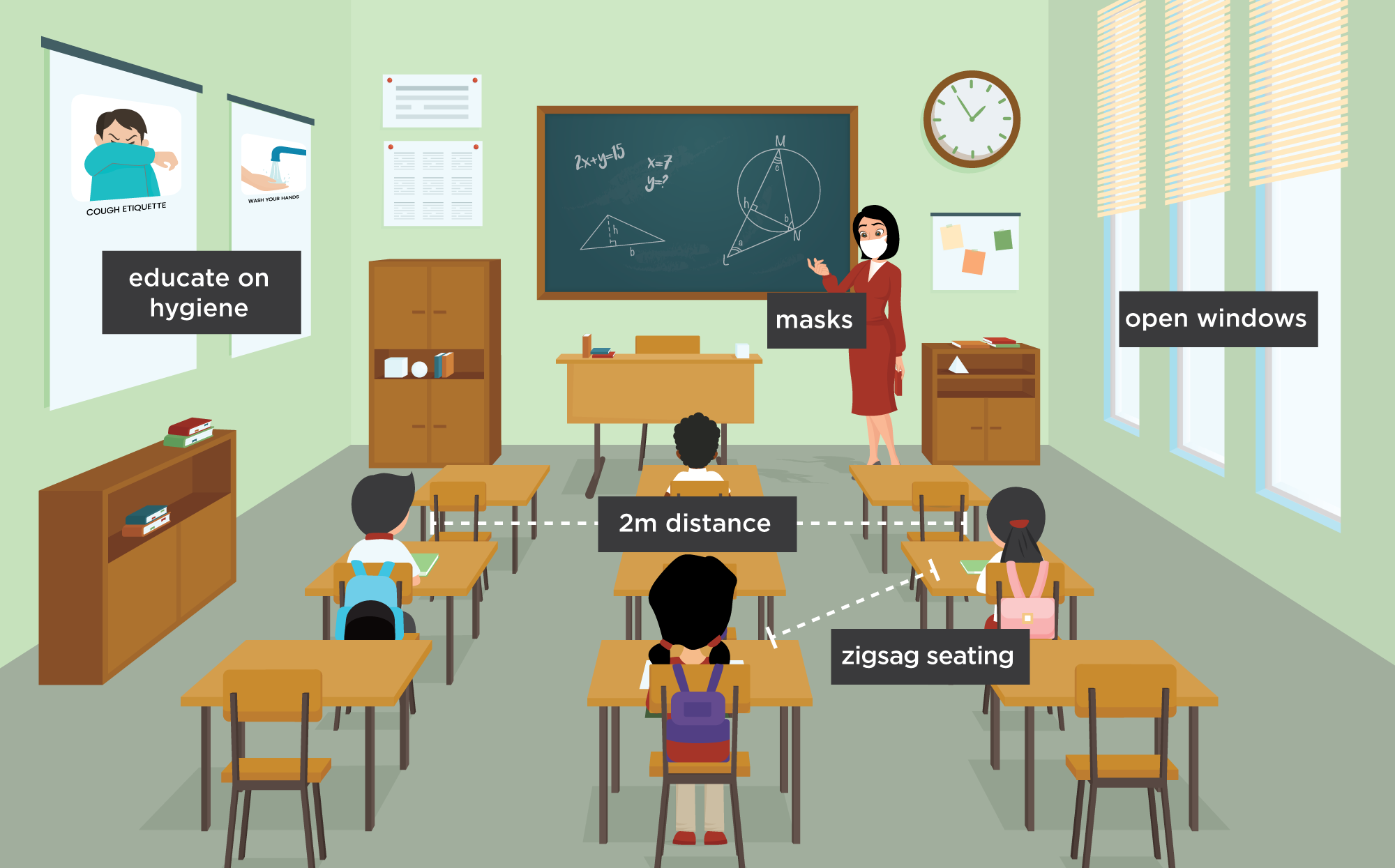
Schools have two functions. One is educating children, and the other is just keeping them away from their parents. Schools are also childcare, and that’s a big part of getting back to work.
The Korean guidelines don’t mention distance learning at all. These recommendations here are technically for after-school academies and study rooms, but still. While distance learning works for older students, younger kids just kinda need to be at school, with precautions.
The basic precautions are:
- 2m distancing
- Masks
- Reduce gatherings (no recess?)
- Ventilation
- Regular disinfection
- Temperature checks, logs, reporting, etc
- Keep old people away
Schools can also educate children about hygiene and generally what’s going on. I would certainly pay more attention to biology during an epidemic.
7. Shopping
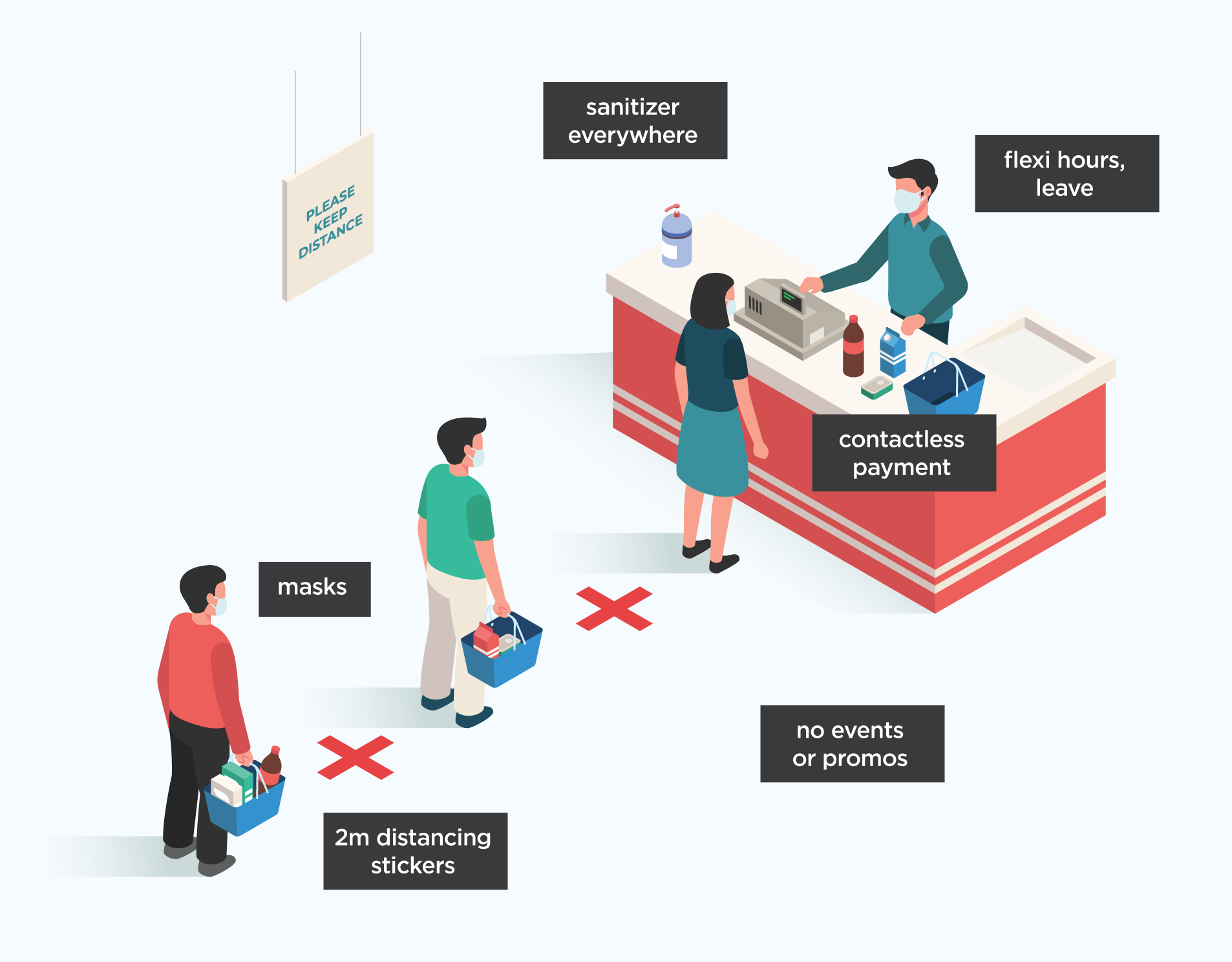
For shops, they recommend literal guidelines on the floor — stickers telling everyone where to stand. People need to wear masks, sanitizer should be everywhere and payment should be as contactless as possible. As long as the whole place is disinfected, shopping should be relatively safe.
On the employee side, workers need flexible hours and generous leave — all of which means more people.
Some ‘normal’ parts of shopping are just finished. People won’t help you find stuff, stores won’t hold promos, kids play areas will be closed, and there’s definitely no free samples. The days of free sausages are over. Just get your stuff and get out.
These guidelines also apply to traditional or ‘wet’ markets. These are not actually full of pangolins, that’s a misunderstanding. I shop at a wet market, or at least I did when we were able to go outside. It’s what westerners would call a farmer’s market — a place that sells vegetables, meat, and fish. Wet markets are often safer than supermarkets because they’re well ventilated. Beyond that, they just need to follow the same guidelines and they’re fine.
8. Weddings/Funerals

I’ve said that some of these cultural changes could be positive. Weddings are definitely worse.
Routing distancing means online weddings, and giving people gifts instead of sharing a meal. If you do have a meal, everyone needs to be 2m apart. This, of course, limits the number of people you can fit into a venue. They say nothing about an open bar.
Beyond that, it’s the usual — disinfect, ventilate and minimize the size and closeness of the group — none of which makes for a dream wedding.
The only positive is that it’ll be cheap. I don’t know about Korea, but in Sri Lanka families go broke to look rich, so I guess that’s a plus. It looks like everybody’s eloping now.
Funerals
Funerals also suck. My late grandmother planned her funeral for years and she would be pissed. You have to invite the minimum number of people, bow instead of hug, and people should leave after 30 minutes. Beyond that the same routine — hygiene, disinfection, ventilation, record-keeping, etc. By this point, I think, you know how it goes.
Religious Events
I’ll include religious events here because they’re much the same. The recommendation is to try live streaming, to use (and not reuse) microphone covers, to avoid large groups, and to avoid sharing food. Korea is a mostly areligious country, but this still heretical.
In Sri Lankan Buddhism we have a tradition where we all sit close together holding one string. This is no longer possible, but change will be hard. Ancient religions are not known for their adaptability, or for avoiding crowds.
9. Hotels
Surprisingly to me, hotels have the least restrictions. Just disinfect and ventilate, check temperatures, educate about hygiene and that’s basically it. I guess it makes sense, it’s not a group activity, and transmission via surfaces is the easiest to control.
10. Hair And Beauty Salons
Americans are about to start an armed rebellion over haircuts, so this seems important. Here also the regulations are light. Just wear a mask and keep 2m between the seats.
They even deem bathhouses OK. I’ve been to a Korean bathhouse and you’re wandering around butt-naked, dipping in various pools, getting scrubbed like the gentleman is scaling a fish. Apparently, this is fine. Maybe not the scrubbing.
11. Movies / Shows / Museums / Sports
You can go to shows, just half-empty ones. As long as people are masked and 2m apart it seems fine. You can’t eat or socialize after, but you can go to a baseball match or a movie.
Since they are now the only sports on Earth, I know that Korean baseball and football are still playing without fans. In time, however, I guess they can.
12. Nightlife
Finally, I mention nightlife because of the Itaewon incident. Last week, one patient had potential contact with over 5,000 people (as recorded in visitor logs). Because those nightclubs were affiliated with the LGBTQ community, there’s a stigma, and stigmas are very dangerous to public health.
Many of the numbers given were fake. People aren’t coming forward. Over 3,000 contacts can’t be traced, and the city is offering anonymous testing to help.
While the clubs kept logs, they’re obviously not maintaining a 2m distance inside. You can barely be heard 2cm away in a nightclub, so it’s not clear how this works at all; for any club, gay, straight, or byzantine.
The recommendations for a nightclub are the usual — zigzag seating, replacing mic covers for karaoke, contactless payment, etc — but it’s hard to overcome what a nightclub is. You’re just rammed up against people. That’s kind of what you pay for.
For now, they’ve simply closed the nightclubs in Itaewon, but it’s hard to see what the new normal will be here. As it is, just one incident has made Korea’s ‘reopening’ a mess.
In Closing
As you can see, reopening is not easy. We have to give up a lot of our culture, our traditions, and you will still get inevitable relapses. It’s not a failure of the plan, you just have to plan for failure.
This is just the new routine. Distancing plus constant vigilance. We have change our daily routines to avoid death becoming routine, as it is in so many countries today. And it is possible. Through constant challenges, East Asian countries like Korea are showing us how, and thanks to the COVID Translate Project we can learn direct.
These are the detailed guidelines for routine distancing in daily life. They’re not that hard and they preserve the most important things about being alive. Not being dead. Being healthy. Being together, even 2 meters apart.
I hope these guidelines help. I recommend reading this and other source documents at the COVID Translate project. Some of the documents are long, but you get a much better understanding than from cursory news reports.
I’ve summarized a few here. Good luck and stay safe.
